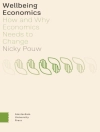Correlation matrices (along with their unstandardized counterparts, covariance matrices) underlie the majority the statistical methods that researchers use today. A correlation matrix is more than a matrix filled with correlation coefficients. The value of one correlation in the matrix puts constraints on the values of the others, and the multivariate implications of this statement is a major theme of the volume. Alexandria Hadd and Joseph Lee Rodgers cover many features of correlations matrices including statistical hypothesis tests, their role in factor analysis and structural equation modeling, and graphical approaches. They illustrate the discussion with a wide range of lively examples including correlations between intelligence measured at different ages through adolescence; correlations between country characteristics such as public health expenditures, health life expectancy, and adult mortality; correlations between well-being and state-level vital statistics; correlations between the racial composition of cities and professional sports teams; and correlations between childbearing intentions and childbearing outcomes over the reproductive life course. This volume may be used effectively across a number of disciplines in both undergraduate and graduate statistics classrooms, and also in the research laboratory.
Spis treści
Series Editors Introduction
Preface
Acknowledgments
About the Authors
Chapter 1: Introduction
The Correlation Coefficient: A Conceptual Introduction
The Covariance
The Correlation Coefficient and Linear Algebra: Brief Histories
Examples of Correlation Matrices
Summary
Chapter 2: The Mathematics of Correlation Matrices
Requirements of Correlation Matrices
Eigenvalues of a Correlation Matrix
Pseudo-Correlation Matrices and Positive Definite Matrices
Smoothing Techniques
Restriction of Correlation Ranges in the Matrix
The Inverse of a Correlation Matrix
The Determinant of a Correlation Matrix
Examples
Summary
Chapter 3: Statistical Hypothesis Testing on Correlation Matrices
Hypotheses About Correlations in a Single Correlation Matrix
Hypotheses About Two or More Correlation Matrices
Testing for Linear Trend of Eigenvalues
Summary
Chapter 4: Methods for Correlation/Covariance Matrices as the Input Data
Factor Analysis
Structural Equation Modeling
Meta-Analysis of Correlation Matrices
Summary
Chapter 5: Graphing Correlation Matrices
Graphing Correlations
Graphing Correlation Matrices
Summary
Chapter 6: The Geometry of Correlation Matrices
What Is Correlation Space?
The 3 × 3 Correlation Space
Properties of Correlation Space: The Shape and Size
Uses of Correlation Space
Example Using 3 × 3 and 4 × 4 Correlation Space
Summary
Chapter 7: Conclusion
References
Index
O autorze
Joseph Lee Rodgers is Lois Autrey Betts Chair of Psychology and Human Development at Vanderbilt University in Nashville. He moved to Vanderbilt in 2012 from the University of Oklahoma, where he worked from 1981 until 2012, and where he holds the title George Lynn Cross Emeritus Professor of Psychology. Joe earned his Ph.D. in Quantitative Psychology from the L. L. Thurstone Psychometric Laboratory at the University of North Carolina, Chapel Hill, in 1981 (and also minored in Biostatistics at UNC). He has held short-term teaching/research positions at Ohio State, University of Hawaii, UNC, Duke, University of Southern Denmark, and Penn. He has published six books and over 175 papers and chapters on statistics/quantitative methods, demography, behavior genetics, and developmental and social psychology. His best-known paper, “Thirteen Ways to Look at the Correlation Coefficient, ” was published in American Statistician in 1988. Joe is married to Jacci Rodgers, an academic accountant (and currently an associate dean of Peabody College at Vanderbilt), and they have two adult daughters; Rachel works for an international development company in DC, and Naomi is a Ph.D. student in Geology at USC in Los Angeles. Joe’s hobbies include playing tennis and golf, reading, and music.












